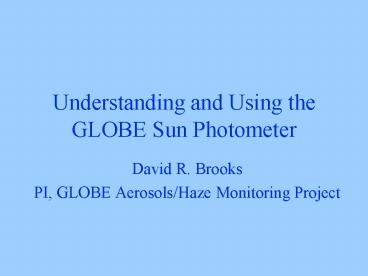Understanding and Using the GLOBE Sun Photometer PowerPoint PPT Presentation
1 / 12
Title: Understanding and Using the GLOBE Sun Photometer
1
Understanding and Using the GLOBE Sun Photometer
- David R. Brooks
- PI, GLOBE Aerosols/Haze Monitoring Project
2
What are aerosols?
- Aerosols are small liquid or solid particles
suspended in the atmosphere. - They come from natural and manmade sources
- volcanoes
- smoke from biomass burning (for example, clearing
land for agricultural purposes) - smog and other air pollution
- dust from agricultural activity and deserts
- trees
- water surfaces (especially from large bodies of
salt water)
3
What are aerosols (continued)?
- They are approximately 100-1000 nm in diameter.
- This range includes visible light (400-700 nm),
so aerosols interact strongly with the atmosphere
and human perception of it. - Most aerosols are found in the troposphere.
- Aerosols from volcanoes can reach the
stratosphere and circle the earth for weeks or
even months. Volcanic aerosols can absorb
sunlight, thereby heating the atmosphere. - Most aerosols reflect and scatter sunlight.
- These aerosols have a cooling effect on the
atmosphere. The sky looks blue because shorter
wavelengths scatter light more efficiently than
longer wavelengths. At sunset, when the sun is
low in the sky, direct sunlight is red because
other colors have been scattered away. - A hazy sky is a visible indicator of aerosols.
4
Why Measure Aerosols?They affect the
- Energy Cycle
- Affect the amount of sunlight reaching Earth's
surface - Water Cycle
- Stimulate formation of water droplets and ice
particles - Biogeochemical Cycles
- Help track the effects of dust storms, fires,
volcanic eruptions and pollution
5
How are aerosols measured?
- Aerosol concentrations are expressed in terms of
"aerosol optical thickness" (AOT) or percent
transmission through the atmosphere. - Aerosol optical thickness is sometimes called
aerosol optical depth. These two terms refer to
the same thing. - The term "optical thickness" (or "optical depth")
provides a way to describe how much sunlight
passes through the atmosphere to reach the
Earths surface. - Optical thickness includes the scattering of
light by molecules in the atmosphere, which
occurs even when no aerosols are present. - The AOT depends on wavelength. A sun photometer
is an instrument that measures direct light from
the sun at a particular wavelength.
6
Instrument for Measuring Aerosols
- Aerosols are measured with a sun photometer.
- Sun photometers can be obtained from the PI for
the measurement see http//www.pages.drexel.edu/
brooksdr/DRB_web_page/Aerosols/order_form.htm
7
How do you use a sun photometer?
- You need to have an unobstructed view of the sun.
- Clouds must not block direct light from the sun
- You need to describe the cloud cover.
- Clear? Isolated? Scattered? Broken? (Not
overcast!) - You need to describe the sky condition.
- Unusually clear, clear, somewhat hazy, very hazy,
extremely hazy - You need air temperature and barometric pressure.
- Pressure is required to calculate AOT.
Temperature helps scientists interpret these
measurements. - Relative humidity is useful for interpreting AOT.
8
How do you use a sun photometer? (continued)
- You need to know the longitude, latitude, and
elevation of your site. - You need to know the time as accurately as
possible. - You need to prevent your sun photometer from
getting too hot or too cold when it is outdoors.
9
Where and When to Observe Aerosols
- Any site will do, wherever you have a clear,
unobstructed view of the sun. - Daily, weather permitting. Ideally, at times of
satellite overpasses of your site. - Multiple measurements per day are desirable.
- At least three pairs of green/red measurements
are required, taken over total time of 2-3
minutes.
10
Remember
- Sun photometers measure in units of volts.
- The GLOBE Data Server will convert volts to
aerosol optical thickness using calibration
values for each individual sun photometer.
(Advanced students can do this as a Learning
Activity). - Aerosol optical thickness (AOT) can range from 0
(100 light transmission) to gt2.0 (13 light
transmission) - The larger the optical thickness at a particular
wavelength, the less light of that wavelength
reaches Earth's surface - A typical AOT value for visible light in very
clear air is roughly 0.05 (95 of light is
transmitted). Very hazy skies can have AOTs of
2.0 or greater.
11
Aerosol Questions We Would Like to Answer
- How do aerosol concentrations change over
seasons? - How are aerosol concentrations related to the
weather? - How does smoke from large forest fires affect
sunlight reaching Earth's surface? - How long do volcanic aerosols stay in the
atmosphere? - How is the amount and distribution of aerosols
changing?
12
Aerosol Optical Thickness in Bahrain, Nov. 2004

